The great expanse of water that is Noah's Lake didn't have the quantity of duck that were present back in January. The same species were present but in much reduced numbers. In January there was the continual whistles of Wigeon, but today there was hardly any calls at all other than the squeak of a Moorhen, or the call of a Little Grebe to its mate.
On a pool close to the path there were several Pochard drakes, scanning the water there was no sign of any females.
We walked all the way to the road that crosses the heath and then turned to the left and headed towards the Canada Farm area. Walking down the track towards the hide there was a Great Spotted Woodpecker and lots of Redwings in the birch trees. In the hide it was very quiet, hardly any duck on the water. At the back of the lake a Marsh Harrier twisted and banked over the trees.
Leaving the hide we walked back along the track to the road. Siskins were feeding in the alder alongside the track and caught this Blue Tit using the many twigs and branches to get a drink from a very dirty muddy pool
We walked back to the bridge that takes the road across the South Drain, with the sun now out the scene looked quite dramatic once again looking towards the Calcott Lows area of the Avalon Marshes
After a coffee in the visitor centre we made our way back towards Ham Wall, the clouds and sun above Noah's Lake produced a quite dramatic landscape, once again in black and white to increase the impact.
We carried the walk along the South Drain and made our way to the first viewing platform on the Ham Wall reserve. Once again the number of duck on the open water was much reduced compared to our visit in January. On the pool on the other side from the viewing platform there was a pair of Great Crested Grebes building a nest together. I watched and waited in the hope that they would enter into a display, but they were more concerned with nest building. Where the reeds had been cut there was a good number of Snipe.
From the viewing platform a female Marsh Harrier drifted across the reeds before dropping down out of view.
A male then appeared and slowly made its way from the back of the reeds and then above us quite high.
We headed back to Litton, where there was still some time to walk around the Litton Reservoirs, these are two reservoirs owned and operated by Bristol Water that can be found close to The Litton where we were staying.
The individual lakes are called Lower Litton and
Upper Litton. The former is 8 acres in size with a shallow area and plenty of
weed, the latter 16 acres and is much deeper than its sister lake and very
different in character. Long and narrow with steep sides, and is fed by the River Chew which flows in at the top end. They were built around 1850 by the Bristol Waterworks to
bring water from the Mendip Hills to Bristol.
We walked from the car park and then followed the footpath that goes around the Upper Litton north bank. The water was quiet but as we walked close to the bank we disturbed Mallard and Coot and this seemed to spark a territory dispute in the Coot. All of a sudden there was splashing and below us a pair of Coot were engaged in a very fierce fight.
When that doesn't deter the intruder and fierce battle is the final recourse and this was what we were now witnmessing
Leaving the Upper Litton we walked down to the lower Litton reservoir, where it was much calmer, up to eight Little Grebe were seen at one time.
The view from the bottom of the lower Litton, looking up to the dam of the Upper Litton.
We then decided to make our way back to the dam and back along the Upper Litton path. This was extremely narrow and very muddy in places. This made it very difficult walking and sometimes in places quite a challenge not to slip down the bank. Finally we reached the main dam and was able to re-trace the path back around the top of the reservoir. The Coot were all quiet as we passed.





































No comments:
Post a Comment